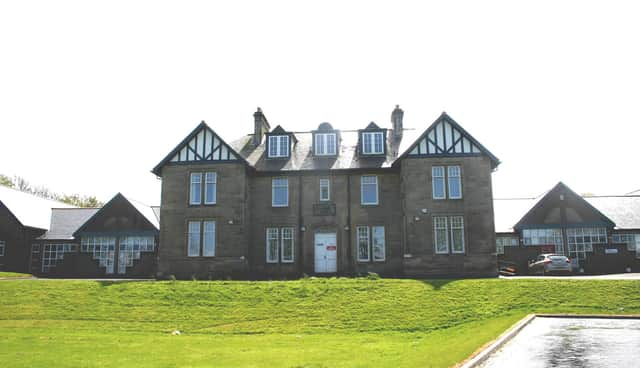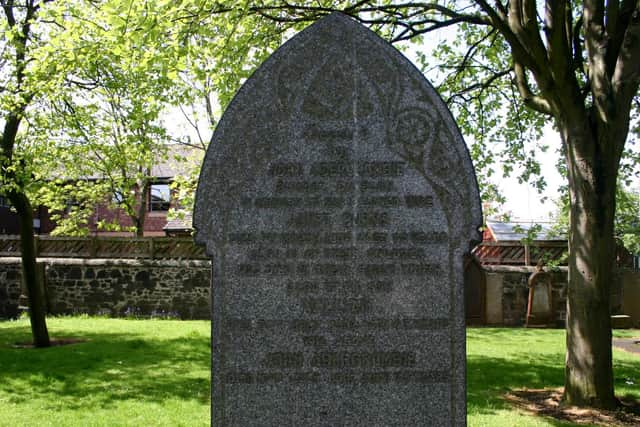Ian Scott: Falkirk hospital building is reminder of Victorian times when life was precarious


It was erected by John Abercrombie, Builder, Camelon, ‘in memory of his beloved wife Janet Burns died 8th March 1896, aged 60 years, and ten of their children who died in their early youth’.
It is not a rare specimen. Many local graveyards tell the same tale of multiple deaths arising from the fevers which haunted overcrowded houses in the new industrial communities of the Victorian age.
Advertisement
Hide AdAdvertisement
Hide AdLack of basic sanitation, contaminated water supplies and inadequate diet left people, especially children, prey to cholera and typhoid fever while the authorities struggled to find a solution in an age when the powerful were reluctant to put up the cash required.


In Falkirk in 1847 an outbreak of fever among the workers on the Midland Junction Railway prompted the Parochial Board to build a small Fever Hospital far from the town centre at the top of the Slamannan Road.
Many ratepayers protested at the cost involved and in the end the building was a cheap structure of wood and slate.
Nothing more was done until the 1860s when it was partially replaced with a more permanent brick structure.
Advertisement
Hide AdAdvertisement
Hide AdIt was a pathetic response to a desperate situation but improved water supplies and housing gradually reduced the fevers.
However new infections including scarlet fever and diphtheria soon appeared and the strain on the accommodation increased again.
Before 1900 Camelon was not part of Falkirk but lay within the Eastern District of Stirling County.
This meant that the Falkirk Burgh Hospital was not automatically available to those from the village who fell ill and the County had to make special payments to the town and also face delays when the numbers were high.
Advertisement
Hide AdAdvertisement
Hide AdIn the early 1890s a decision was taken to build a new hospital in Camelon to serve the district which of course included Bonnybridge, Larbert and Stenhousemuir.
Falkirk’s leading architect William Black designed the fine new building which stands today not far along the Glasgow Road from the churchyard.
In December 1896, the very year that Janet Abercrombie was laid to rest, the building was opened by George Ure, the iron master from Bonnybridge.
As was the norm in those days the place was packed with politicians, clergymen and gentlemen of leisure and there were many speeches and much self congratulation.
Advertisement
Hide AdAdvertisement
Hide AdThe building had wards for scarlet and typhoid fevers as well as all the usual ancillary accommodation.
The central block housed the administration and nurses’ rooms and the whole building cost £8000.
In the 20th century the hospital began to offer general care and demand rose dramatically.
Disaster struck when a fire all but destroyed the main central building but this apparent calamity offered the opportunity to extend as well as replace the previous accommodation and in particular provide more and better staff quarters.
Advertisement
Hide AdAdvertisement
Hide AdThe remodelled building we see today was officially opened in July 1925 just 18 months after the fire.
The hospital served until 1958 when it was converted into a sheltered workshop for the disabled and later served for many years as a Day Centre for adults with learning disabilities.
Today it is on the market and, of course, my hope is that it survives the bulldozers and remains there as a reminder of those Victorian days when life was precarious and many families faced personal tragedies that are difficult for us to comprehend.
Message from the editor:
Thank you for reading this article on our free-to-read website. We're more reliant on your support than ever as the shift in consumer habits brought about by Coronavirus impacts our advertisers.
Please consider purchasing a subscription to our print newspaper to help fund our trusted, fact-checked journalism.
Comment Guidelines
National World encourages reader discussion on our stories. User feedback, insights and back-and-forth exchanges add a rich layer of context to reporting. Please review our Community Guidelines before commenting.
